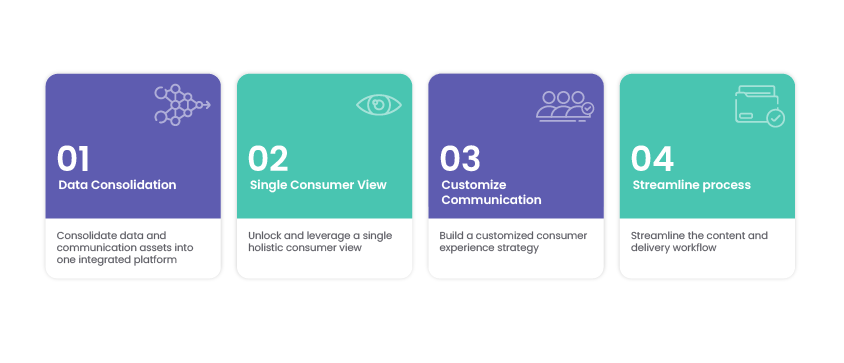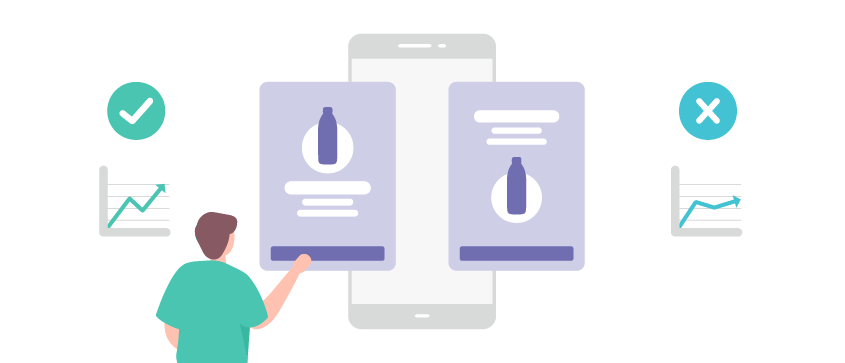Delivering data-driven communications involves collecting information about how people purchase and using that information to create more engaging customer communications. With the continuous changes in buying behaviors, brands are creating offers that meet consumers’ needs at the right time. Data-driven communications involve leveraging customer information to develop communication that resonates with the consumers.
What are the essential purposes of data-driven communication?
Data-driven communication leverages assets from various database platforms to deliver timely, responsive, and highly personalized messages across multiple channels. It enables brands to manage their omnichannel strategy faster, smarter, and more efficiently.
What are the crucial steps of such a strategy?

Building a data-driven communication strategy requires four critical steps:
- Consolidate data and communication assets into one integrated platform
- Unlock and leverage a single holistic consumer view
- Build a customized consumer experience strategy
- Streamline the content and delivery workflow
The critical outcomes of data-driven communication

Primary challenges in driving data-driven communication strategy
- Only a very few organizations recognize the importance of the acquisition, enrichment, and activation of data.
- Many businesses lack the budget and the capabilities to perform comprehensive analytics and modeling.
- New legislation that is designed to protect consumer rights often limits the scope and the means of acquiring the right consumer data.
Steps to Overcome the impending challenges
- Leverage third-party public data to create a powerful, intense message without violating the consumer’s desire for privacy.
- Create a discipline and system to systematically acquire consented first-party data either directly or through the right and responsible technology partners.
- Identify other sources that collect first-party data for similar categories or audiences to create an ecosystem of Second-Party data acquisition and usage.
- Implement data-matching and data-enrichment “clean room” to continuously augment consumer data to derive real-time insights and communication.
“Research & Analytics is the Smarter ways to drive data-driven communication”
Research can be expensive, time-consuming, or even overwhelming. But qualitative research components (the non-statistical data) can be easy to extract by simply reading customer reviews, through word-of-mouth, or by observing industry trends.
Quantitative components, like surveys and web analytics, are now more accessible than ever. With the emergence of digital communications, companies have loads of quantitative data for situational analysis. The real challenge will be deciphering which data will provide the most value for the strategic communications plan.
There are three key sources of acquiring essential quantitative data that can provide a sound foundation for the data-driven communication strategy.
- Website Analytics: Be it Google Analytics or any other solutions, website data is vital for learning how customers navigate a particular website. What content resonates the most with the consumers? What content helps close the sale? What are the key traffic sources, and where are we getting the high bounce rates? Analyzing this data will help identify the brand’s SWOT.
- Social Media Analytics: Dig deeper into the data from a brand’s social channels can help determine consumer growth, consumer sentiments, key demographics, and engagement rates. Like website data, social media analytics also offer challenging insights that cannot be obtained through regular qualitative research and will also help identify opportunities and threats for a brand.
- Reputation Analytics: Google Alerts to monitor mentions of a brand or a company and its key competition and send real-time notifications directly to the brand owners is an essential tool for reputation management for the brand. This data will provide further insight into opportunities and threats with qualitative research – by capturing what is said about your brand and competition – and quantitative information – on the number of mentions you receive and when they appear online.
Research doesn’t have to be a painful and expensive part of strategic communication planning.
How one obtains qualitative and quantitative data will depend on the adopted process and setup for a solid situational analysis.

At Grivy, we take you on an end-to-end journey from learning to implementing the best alternative. With A/B testing of creative communications, we enable you with insights on what works best and help you optimize your campaigns on the go by integrating these insights to formulate a compelling creative with clear messaging topped with the perfect CTA to skyrocket reach and consumer responses.




